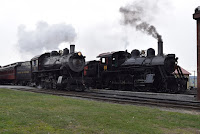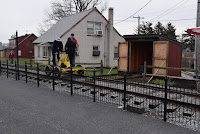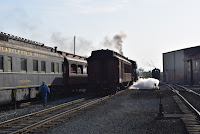Frank writes...
So Sunday was "Daniel Tiger Day" at IRM, or "Be My Neighbor Day" or something like that. Regardless, there was a pretty big crowd. The traffic flow was very interesting: the public entered at the new entrance across from the Schroeder Store and visited the two costumed characters, Daniel and Katerina Kitty, at the front of Barn 4 and in a Rock Island car parked on the 50th Avenue west track respectively. And that was mostly it. While there were some people wandering around, and the playground was pretty well patronized, the rest of the property - and, notably, the area around the depot - wasn't all that busy.
Over in front of Barn 4 our very own neighborhood trolley, Veracruz 19, served as a backdrop for people to take photos of their kids with Daniel Tiger. The weather was gorgeous, probably nice than it's been all year, which certainly helped tremendously with attendance.
And boy was there attendance! The line to see Daniel Tiger stretched down to Barn 7 at one point. The event was run entirely by WTTW, our local PBS station, and there was some concern about people being unhappy with the long lines. But for the most part everyone seemed to be having a great time.
Besides the two CA&E steel cars, the CTA 4000s were also running and the 415 and 3142 were in service on the car line along with the Matchbox. Here's the 1374 boarding at Depot Street with Norm Krentel as motorman and Jon Fenlaciki as conductor.
While I was hanging around the area, I snapped this picture of the former site of the bookstore and gift shop cars just east of the depot. The north track is gone, except for ties, and the south track has been taken apart for removal. The platform has been scrapped and the ramps are currently sitting on Central Avenue next to Barn 6. Sic transit gloria mundi...
...though in this case the gloria has only transited over to Station Track 2, where three of the four former store cars await future use. The fourth car, the streamlined RPO/baggage car that used to serve as the gift shop, has already been relocated elsewhere on the property.
Other than that, I spent most of my time moving spare seat cushions - most of them from the CA&E - into storage. These were obtained during the Trolleyville acquisition back in 2010 as part of IRM's allotment of spare parts and since that time have been sitting in a truck trailer. But we're trying to put them into more permanent storage. Many of the cushions are dark red leatherette, which only one preserved CA&E car - the 409 - has. This work wasn't particularly exciting or photogenic though.
But here's something to pique your interest: among the other stuff from Trolleyville was this armature oven, which will shortly acquire a new home, possibly in the lean-three. That could be useful. In the right background is the old North Shore signal shanty which for many years served as our oil shed. It is on the short list for restoration by the Car Department.
And there was plenty of other activity going on. The big project was annual inspection of the CTA 2200s, which were on the pit. Good Nick, Joel, and Richard among others were working on this. And shown above is the air compressor from CA&E 451. Brian and Richard, among others, worked on installing the newly-rebuilt armature on this compressor prior to reassembling the whole thing and putting it on the car. This is part of the push to get the 451 running this year.
I didn't get much done on the 18, though with help from Joel I did make a little bit of progress on replacing a broken end window. But the real progress on the 18 was happening outside the barn door, where Mark Secco was working on the CGW wrecker. He is trying to get a clutch working, and once he does the boom can be raised and the wrecker can be moved out of the way. At the moment it's immobile and preventing us from moving the 18 under wire for further work. But progress is being made by Mark. He showed me around the body of the wrecker; above is the operator's cab, with the gearing and hoisting equipment to the left.
And finally, while I was helping Joel put some stuff away in one of the boxcars, I stumbled upon a random grab iron which probably nobody except me would recognize. But I knew it immediately: the missing grab from the 205's doors! This story goes back at least ten years, to when the middle two leaves of the car's folding doors - which were really shot - were removed and new ones were made. All of the hardware was removed from the old door leaves in late 2007 and when the new doors were ready in mid-2008 all of the hardware was reinstalled - all, that is, except for the angled grab iron from one of the doors which had inexplicably gone missing over the previous winter. Well I always figured that it might turn up someday and it finally did, so I very happily took it over to the 205 and installed it. It's seen above on the left, ready to assist people climbing the steps. The one on the right was installed on that door almost a decade ago. Better late than never.



























































